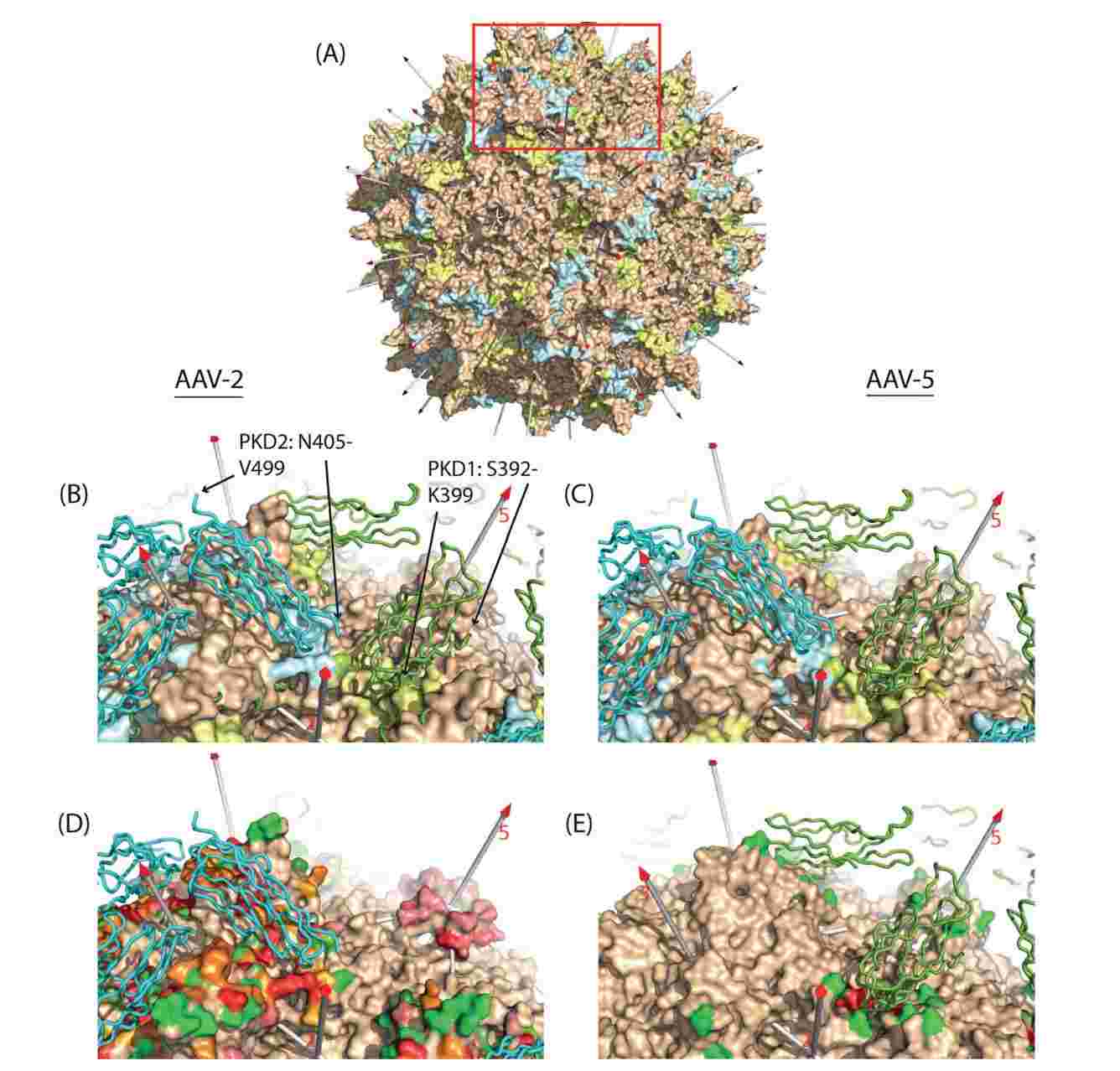Structural Research of Adeno-associated Virus
Adeno-associated virus (AAV) is an envelope-less, single-stranded DNA virus of the parvovirus family that generally triggers only a mild immune response and can only replicate if other viruses simultaneously infect the host. Therefore, researchers believe that AAV is suitable for modification for use as a vector for human gene therapy and for the construction of in vitro isogenic human disease models. In recent years, recent advances in developing clinically relevant AAV coatings, optimizing genome design, and utilizing revolutionary biotechnology have contributed significantly to the development of the gene therapy field.
 Figure 1. Sites of Adeno-associated virus (AAV) interactions with AAV receptor (AAVR). (Meyer NL, Chapman MS, 2022)
Figure 1. Sites of Adeno-associated virus (AAV) interactions with AAV receptor (AAVR). (Meyer NL, Chapman MS, 2022)
Genome Structure of Adeno-associated Virus
AAV has emerged as a highly sought-after gene therapy vector, receiving extensive research attention. Research has shown that AAV consists of a protective protein shell encapsulating a small, single-stranded DNA genome of approximately 4.8 kb in size. Its single-stranded genome encompasses three genes: Rep (Replication), Cap (Capsid), and aap (Assembly). The Rep gene encodes four proteins, crucial for viral genome replication and packaging. On the other hand, Cap expression yields viral capsid proteins (VP; VP1/VP2/VP3), which form the outer capsid shell safeguarding the viral genome, while also playing an active role in cell binding and internalization. It is estimated that the viral coat comprises 60 proteins arranged in an icosahedral structure, with the capsid proteins present in a molar ratio of 1:1:10 (VP1: VP2: VP3). The aap gene encodes the assembly-activating protein (AAP) in an alternate reading frame that overlaps with the cap gene. This nuclear protein is believed to provide a scaffolding function during capsid assembly.
Advances in Structural Research on Adeno-associated Virus Entry into Cells
AAV is the predominant vector for the development of therapies for inherited diseases. The need to improve transduction efficiency and cell specificity to expand their clinical applications has prompted research into the molecular interactions between viruses and hosts during cell entry. Utilizing high-throughput methods allows for a more comprehensive characterization of the host proteins involved, and cryo-electron microscopy (cryo-EM) has provided a promising avenue to gain insight into the structure of the virus-host complex, promising to further unravel the complex steps involved in viral entry. Cryo-EM defines a receptor-binding footprint with implications for serotype specificity and host immunity, which is demonstrated by two high-resolution maps (2.4 Å and 2.8 Å) showing that the AAVR structural domain is tightly bound to each spike around the triple axis.
| Cat No. | Product Name | Virus Family | Source | Composition |
| CBS-V539 | Adeno-associated virus 1 VLP (VP1; VP2; VP3 Proteins) | Parvoviridae | Mammalian cell recombinant | VP1; VP2; VP3 |
| CBS-V964 | Adeno-associated virus 2 VLP (VP1; VP2; VP3 Proteins) | Parvoviridae | Mammalian cell recombinant | VP1; VP2; VP3 |
| CBS-V965 | Adeno-associated virus 3 VLP (VP1; VP2; VP3 Proteins) | Parvoviridae | Mammalian cell recombinant | VP1; VP2; VP3 |
| Explore All Adeno-associated Virus VLP Products | ||||
Creative Biostructure specializes in providing comprehensive services and products to satisfy the critical role of AAV in the development of gene delivery systems for clinical applications. Our team of experts utilizes cutting-edge techniques such as cryo-EM to reveal the structural details of AAV and its interactions with host cells, providing valuable insights into the complex structural and molecular characterization of AAV.
In addition to our research services, we offer high-quality virus-like particles (VLPs) products. These VLPs serve as versatile tools for drug delivery, vaccine development, and other gene therapy applications. If you are interested in our products and services, please feel free to contact us. With our commitment to scientific excellence and dedication to supporting the advancement of gene delivery systems, we are your trusted partner in utilizing the potential of AAV for clinical success.
References
- Meyer NL, Chapman MS. Adeno-associated virus (AAV) cell entry: structural insights. Trends Microbiol. 2022. 30(5): 432-451.
- Naso MF, et al. Adeno-Associated Virus (AAV) as a Vector for Gene Therapy. BioDrugs. 2017. 31(4): 317-334.
- Wang D, et al. Adeno-associated virus vector as a platform for gene therapy delivery. Nat Rev Drug Discov. 2019. 18(5): 358-378.